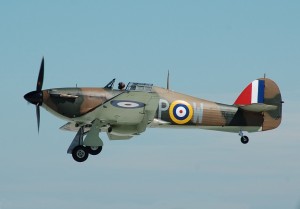Good morning, Whitewater.
The work week in Whitewater ends with mostly sunny skies and a high of eighty-two. Sunrise is 5:26 and sunset 8:34, for 15h 07m 38s of daytime. The moon is a waning crescent with 32% of its visible disk illuminated.

Hawker Hurricane R4118 fought in the Battle of Britain. Here it arrives at the 2014 Royal International Air Tattoo, England. Via Wikipedia.
On this day in 1940, and lasting for over a hundred days, the Battle of Britain begins:
The Battle of Britain (German: Luftschlacht um England, literally “Air battle for England”) is the name given to the Second World War air campaign waged by the German Air Force (Luftwaffe) against the United Kingdom during the summer and autumn of 1940. The Battle of Britain was the first major campaign to be fought entirely by air forces,[18] and was also the largest and most sustained aerial bombing campaign to that date.
The objective of the Nazi German forces was to achieve air superiority over the Royal Air Force (RAF), especially its Fighter Command. Beginning in July 1940, coastal shipping convoys and shipping centres, such as Portsmouth, were the main targets; one month later, the Luftwaffe shifted its attacks to RAF airfields and infrastructure. As the battle progressed, the Luftwaffe also targeted factories involved in World War II aircraft production and ground infrastructure. Eventually the Luftwaffe resorted to attacking areas of political significance and using terror bombing strategy.[nb 10]
By preventing Germany from gaining air superiority, the British forced Adolf Hitler to postpone and eventually cancel Operation Sea Lion, a planned amphibious and airborne invasion of Britain. However, Germany continued bombing operations on Britain, known as The Blitz. The failure of Nazi Germany to achieve its objective of destroying Britain’s air defences in order to force Britain to negotiate an armistice (or even surrender outright) is considered by historians to be its first major defeat in World War II and a crucial turning point in the conflict.[20]
On this day in 1832, during the Black Hawk War, soldiers begin building a fort:
1832 – Fort Koshkonong Construction Begins
On this date General Henry Atkinson and his troops built Fort Koshkonong after being forced backwards from the bog area of the “trembling lands” in their pursuit of Black Hawk. The Fort, later known as Fort Atkinson, was described by Atkinson as “a stockade work flanked by four block houses for the security of our supplies and the accommodation of the sick.” It was also on this date that Atkinson discharged a large number of Volunteers from his army in order to decrease stress on a dwindling food supply and to make his force less cumbersome. One of the dismissed volunteers was future president, Abraham Lincoln, whose horse was stolen in Cold Spring, Wisconsin, and was forced to return to New Salem, Illinois by foot and canoe. [Sources: History Just Ahead: A Guide to Wisconsin’s Historical Markers edited by Sarah Davis McBride and Along the Black Hawk Trail by Willilam F. Stark]
A Google a Day asks a geography question:
The expansion of the earth’s surface is demonstrated by what U.S. state that is believed to be increasing by 1.2 “nanostrains” per year?
